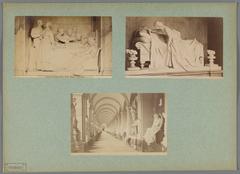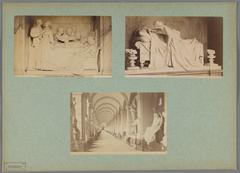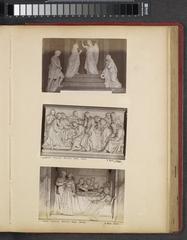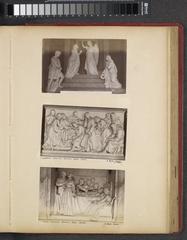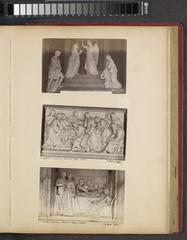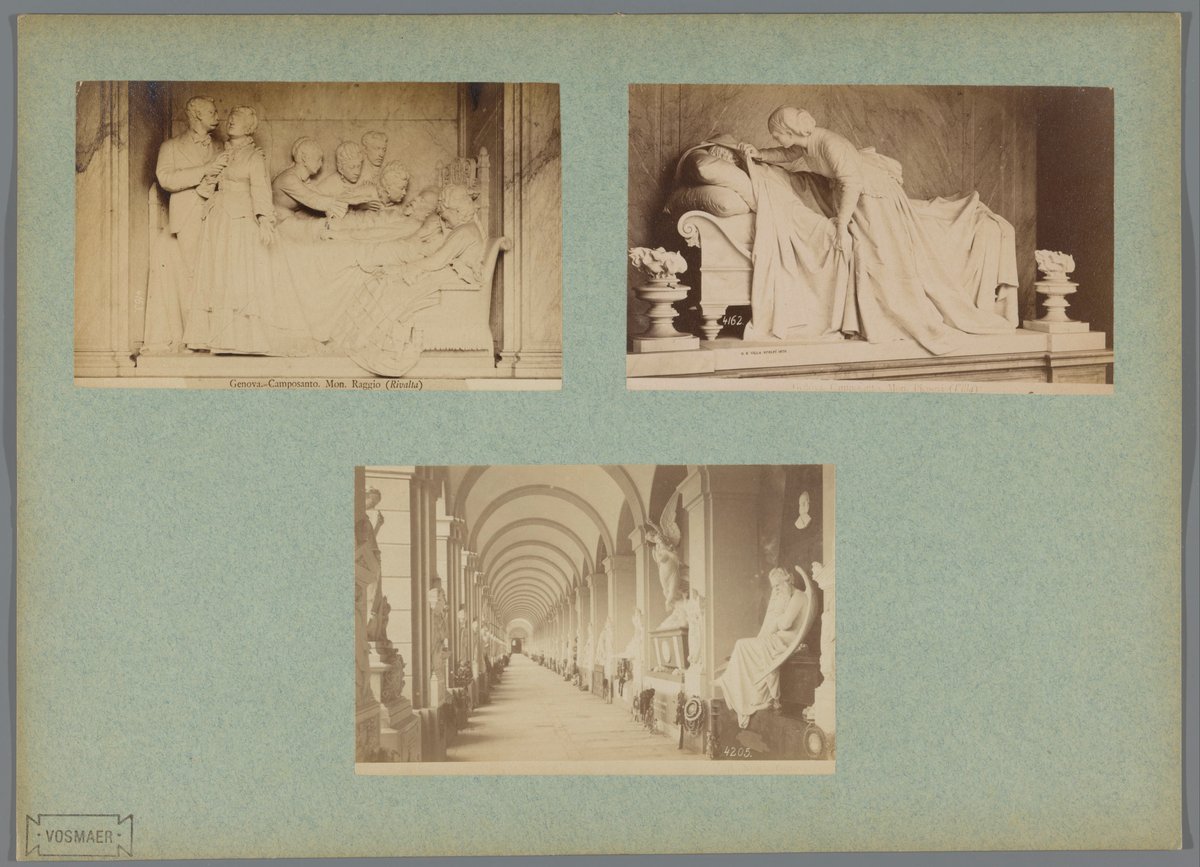
Tomba Carlo Raggio Visiting Hours, Tickets, and Genoa Historical Sites Guide
Date: 14/06/2025
Introduction: The Significance of the Tomba Carlo Raggio in Genoa
The Tomba Carlo Raggio, nestled within the renowned Cimitero Monumentale di Staglieno in Genoa, Italy, is a striking emblem of 19th-century Italian funerary art and the city’s dynamic industrial past. Commissioned by the influential Raggio family—key figures in Genoa’s maritime trade and industrial rise—the tomb not only signifies their social prominence but also reflects the city’s broader economic and cultural transformation. Sculpted in 1872 by Augusto Rivalta, a master of the “realismo borghese” style, the monument features lifelike depictions of family mourning, marking a shift in funerary sculpture toward secular humanism and personal narrative.
Staglieno Cemetery itself, inaugurated in 1851 and spanning over 330,000 square meters, is famed for its extraordinary collection of funerary art, blending neoclassical, Gothic, Art Nouveau, and Art Deco elements. It serves as a unique open-air museum, attracting admiration from writers and travelers worldwide. For visitors, Staglieno offers free entry, regular opening hours, accessibility via public transport, and enriching guided tours. The Tomba Carlo Raggio forms part of a larger itinerary through Genoa’s historical heart, complemented by nearby landmarks like Palazzo Ducale and Genoa Cathedral. For up-to-date details and interactive tools, consult the official cemetery website and the Audiala app (Wikimedia Commons; Genova Città Segreta; Fodor’s; Staglieno Official Site).
Contents
- Historical Background of the Raggio Family
- Artistic and Architectural Significance
- Socio-Economic and Cultural Context
- Staglieno Cemetery: A Historic Landmark
- Visiting Hours and Ticketing
- Directions and Accessibility
- Guided Tours and Visitor Services
- Artistic Features and Symbolism
- Nearby Attractions in Genoa
- Visitor FAQs
Historical Background of the Raggio Family
The Raggio family emerged as one of Genoa’s leading industrial and maritime dynasties in the 19th and early 20th centuries. Carlo Raggio (the Elder) was a pioneering shipowner and president of the Society for Marine Transport, creating vital shipping links between Italy and South America (Wikimedia Commons). His descendant Carlo Giuseppe Francesco Raggio (1876–1926) diversified the family’s influence into steelworks, textiles, coal, and banking, investing in major firms and furthering Genoa’s role as an industrial and economic powerhouse (Wikipedia IT). The family’s fortune, estimated at 200 million lire, was channeled into new business ventures and agricultural development, reflecting the era’s broader economic shifts.
Artistic and Architectural Significance of the Tomba Carlo Raggio
Located in Sector D, number 10 of Staglieno Cemetery, the Tomba Carlo Raggio is a testament to the Raggio family’s social status and cultural aspirations. Sculpted in 1872 by Augusto Rivalta, the monument embodies the “realismo borghese” style, characterized by detailed, emotionally resonant scenes set in domestic environments (Genova Città Segreta). Unlike traditional allegorical or religious motifs, Rivalta’s work depicts the grieving Raggio family gathered around the patriarch’s deathbed, emphasizing human connection and secular reflection (Staglieno Comune di Genova). The tomb’s Gothic spires, designed by Rovelli and rising dramatically from the hillside, underscore the family’s prestige and the era’s fascination with medieval forms (Fodor’s).
Socio-Economic and Cultural Context
The Raggio family’s business ventures were integral to Genoa’s transformation into a modern industrial city, facilitating trade and migration across the Mediterranean and to South America (Wikimedia Commons). The construction of their monumental tomb at Staglieno reflects the values and ambitions of the Italian bourgeoisie, who used funerary art to assert identity and social status. The tomb’s prominent placement and elaborate design stand as enduring markers of this tradition.
Staglieno Cemetery: A Historic Landmark
The Cimitero Monumentale di Staglieno is one of Europe’s most significant cemeteries, both for its scale and artistic richness. Designed by Carlo Barabino and completed by his pupil Giovanni Battista Resasco, the cemetery opened in 1851 in response to health reforms prohibiting urban burials (Visit Genoa PDF). Over time, Staglieno evolved into a vast, terraced landscape adorned with mausoleums, sculptures, and chapels that reflect Genoa’s changing tastes—from neoclassical to Art Deco (Discover Genoa; Bimbe in Viaggio). The cemetery is also a historical mirror of Genoese society, housing over 115,000 graves, including prominent Italians and international figures.
Visiting Hours and Ticketing
- Opening Hours:
- April–September: 7:30 AM–5:30 PM
- October–March: 7:30 AM–4:30 PM
- Hours may vary on holidays; check the official website for updates.
- Tickets:
- Entry is free for individual visitors.
- Guided tours may require a modest fee and advance booking.
Directions and Accessibility
- Address: Piazzale Resasco, 16137 Genoa, Italy
- By Bus: AMT bus lines 34, 48, and 480 from the city center stop near the main entrance.
- By Train: From Genova Brignole station, take a bus or taxi.
- Parking: Available near the cemetery.
- Accessibility: Main avenues are wheelchair-friendly; older sections can be challenging. Wear comfortable shoes for uneven terrain.
For detailed directions, consult the Geoportale del Comune di Genova.
Guided Tours and Visitor Services
- Guided Tours:
- Offered by the Comune di Genova and local tour operators in Italian and, in peak seasons, English.
- Tours last 1.5–2 hours and highlight the Tomba Carlo Raggio along with other major monuments.
- Book via the official Staglieno website or at the visitor center.
- Visitor Etiquette:
- Photography for personal use is allowed; be discreet and respectful.
- Maintain silence and decorum; supervise children closely.
Artistic Features and Symbolism
The Tomba Carlo Raggio stands out for its Gothic spires, vertical lines, and pointed arches, alluding to aspiration and transcendence. Rivalta’s lifelike marble sculptures focus on the themes of family, memory, and acceptance of mortality, eschewing supernatural elements in favor of humanistic realism (Genova Città Segreta; Staglieno Comune di Genova). The tomb’s integration with its wooded surroundings enhances its contemplative atmosphere.
Nearby Attractions in Genoa
After visiting Staglieno, explore:
- Palazzo Ducale: Genoa’s grand ducal palace and cultural center.
- Genoa Cathedral: A Romanesque-Gothic masterpiece.
- Via Garibaldi: Lined with UNESCO-listed palaces.
- Porto Antico: Historic port area with museums and restaurants.
- Caruggi District: Medieval alleys rich with local flavor.
Frequently Asked Questions (FAQ)
Q: What are the opening hours of Staglieno Cemetery?
A: Generally open from 7:30 AM to 5:30 PM (April–September) and 7:30 AM to 4:30 PM (October–March). Check the official website for updates.
Q: Is the Tomba Carlo Raggio included in guided tours?
A: Yes, most tours of Staglieno highlight the Tomba Carlo Raggio.
Q: Are there entrance fees?
A: Individual entry is free; guided tours may require a ticket.
Q: Is the cemetery accessible for visitors with disabilities?
A: Main avenues are accessible; some historic areas have uneven terrain.
Q: Can I take photographs inside the cemetery?
A: Yes, for personal use and with appropriate respect for the site.
Enhance Your Visit
- Use interactive maps and virtual tours on the official Staglieno website.
- Download the Audiala app for guided audio tours and themed itineraries.
- Consult staff at the visitor center for printed maps and further guidance.
Visual Resources
Plan Your Visit and Stay Connected
Immerse yourself in Genoa’s history and art by planning a visit to the Tomba Carlo Raggio and Staglieno Cemetery. Download the Audiala app for guided tours, interactive maps, and insider tips. Follow us on social media for the latest news about Genoa’s cultural sites and events.
For more information, visit:
Summary and Invitation
The Tomba Carlo Raggio is a masterpiece of Italian funerary art, encapsulating Genoa’s transformation from a seafaring republic to a modern industrial city. Free to visit, rich in history, and easily accessible, it is a must-see for travelers interested in art, history, and cultural heritage. Make the most of your visit with guided tours, interactive tools, and by exploring Genoa’s other historic sites. For the best experience, plan ahead using official resources and the Audiala app (Staglieno Official Site; Lonely Planet; Discover Genoa).
References
- Wikimedia Commons: Carlo Raggio (ship owner)
- Genova Città Segreta: Augusto Rivalta, Scultore
- Staglieno Official Site: Tomba Carlo Raggio
- Lonely Planet: First-Time Guide to Genoa
- Staglieno Official Site: Interactive Map
- Visit Genoa PDF: Monumental Cemetery of Staglieno
- Discover Genoa: Genoa Cemetery
- Bimbe in Viaggio: Monumental Cemetery Staglieno Genoa
- Staglieno Official Site: Guided Tours

